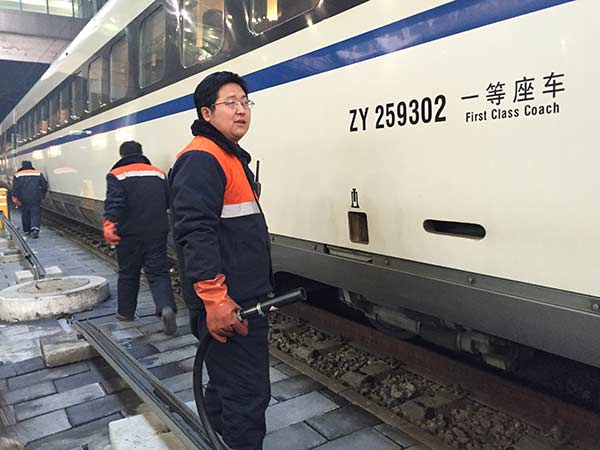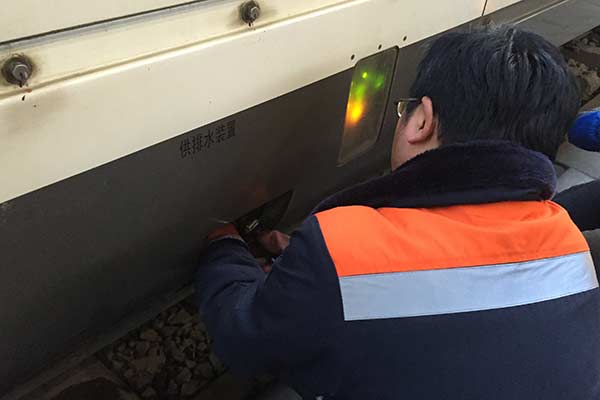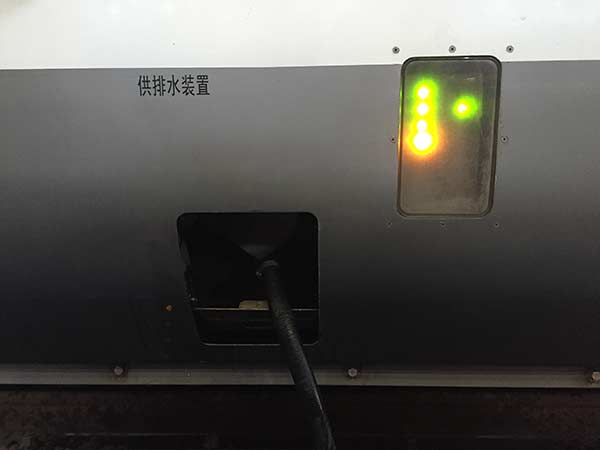 |
|
Li Jian holds a hose to fill up the water tank on Feb 2 at Beijing West Railway Station. [Photo by Liu Wei/chinadaily.com.cn]
|
Li Jian is one of many ordinary railway workers who can supply the answer to the question "Where does the water on the train come from?", if you ever asked.
All passenger trains starting or ending their journeys at Beijing West Railway Station need constant supplies of water and the task falls to the railway staff that spends more than 12 hours a day walking between parked trains.
Maintaining supplies is no easy job.
Li Jian said he has to rise at 5 am to be on time for a 12-hour day shift which is followed by a night shift the next day.
"I can walk more than 20 kilometers back and forth every day just to fill up water for carriages," said Li.
Workers use hoses to fill tanks in carriages and pull them off when tanks are full before trains depart.
Usually it takes about 20 minutes for a three-man team to fill a 16-carriage train.
"If we don't hurry up, some passengers may not have any water during the trip. Delay is the most concern for us, that means the limited time for us to supply water can be a problem," Li said.
According to Jiang Zhaozhong, chief of the water supply department at the station, two shifts rotate between 7:30 am and 19:00 pm and 18:30 pm to 8:00 am.
"We are supplying water to 7,000 carriages per day with the efforts of our crew of 70 people," said Jiang.
Each carriage has a capacity of one ton of water, which means workers put 7,000 tons of water into trains daily, the equivalent of 4.7 standard swimming pools.
Water supplied is the only source when passengers are on the train, using it for drinking, washing and using the toilet.
"We have to be very careful when we walk in the path between two rails. Sometimes when you're filling one train up, another arrives behind your back. You must not be too close to it," said Li.
Workers say a passing train creates a powerful draft which can knock people over though it does not appear to be moving fast at all. The wind becomes an invisible enemy in winter when temperatures plunge below freezing point.
"Several hours working outside is no joke," said Li. "It's freezing cold and my hands have scars due to cold all the time".
When workers pull the hose off the tanks there's usually some water left in the pipe which falls onto their shoes and trousers and can turn to ice and freeze their clothes very quickly.
It won't get any easier in summer either. Temperatures can reach 60 degrees Celsius when the heat the train emits is added to the summer sun, and then workers clothes get drenched with sweat.
Spring Festival is the busiest period as 71 trains are temporarily added to accommodate the huge number of passengers heading home.
Thirty million trips are estimated to be made during the Spring Festival period from Jan 24 to March 3, totaling 40 days, according to Ye Kuankuan, chief of the passenger train control center in Beijing.
 |
|
Li Jian fills up a water tank. [Photo by Liuwei/chinadaily.com.cn]
 |
|
The water hose pumps water into the tank. [Photo by Liu Wei/chinadaily.com.cn]
|
|
"We don't have holidays during Spring Festival. We are too busy helping families prepare for this festive day. I fill up the trains with water to make passengers comfortable. They have water on the train. That means a lot to me," Li said.
By Liu Wei (chinadaily.com.cn)
Using WeChat? Scan QR Code or Press the Fingerprint Below ↓
--- (Or ADD WeChat ID: OKOKOKOKnet)
